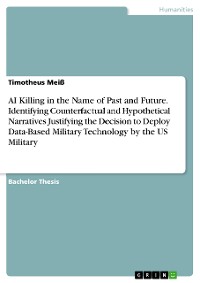AI Killing in the Name of Past and Future. Identifying Counterfactual and Hypothetical Narratives Justifying the Decision to Deploy Data-Based Military Technology by the US Military
Timotheus Meiß
Sozialwissenschaften, Recht, Wirtschaft / Sonstiges
Beschreibung
Bachelor Thesis from the year 2024 in the subject Sociology - Culture, Technology, Nations, grade: 1,3, European University Viadrina Frankfurt (Oder) (Kulturwissenschaften), language: English, abstract: The decision to integrate and deploy data-based enhanced advanced military weapon systems as a military solution by the US military is inspected more closely. In order to narrow the scope, this work will focus on narratives of hypothetical and counterfactual nature, drawing on a cultural scientific theory of decision-making. Whereas hypothetical narratives leverage consequences of decisions, counterfactuals focus on the contingent nature of decisions by highlighting not-selected alternatives within the decision-making process and their potential outcomes. Within the field of data-based technology, such as Artificial Intelligence (AI) and the decision making surrounding the technology, both hypothetical future scenarios and their counterfactual counterparts can be identified. While hypotheticals focus on anticipating future developments of a technology with unclear capabilities, counterfactual narratives are used to fix shortcomings in the past by providing a seemingly universally applicable solution. Both narratives create distorted impressions of the usefulness and prowess of Artificial Intelligence. Counterfactual and hypothetical narratives justifying the decision by the US military to deploy data-based technology will be examined from a standpoint of cultural-scientific analysis of decision-making. The integration of these technologies into the realm of warfare was initiated under a unique constellation of social and political structures that are intertwined with the decision-making process. Investigating the circumstances in which a decision was made will enable the examination of narratives that justify the decision. The decision to implement a technology should be supported by a strategic necessity. It also ought to be preceded by establishing sufficient infrastructure to and enable the technology to fulfil its intended role. Moreover, narratives justifying the decision are meant to ward off criticism of blindly integrating AI into military applications. By providing exemplary criticism detailing possible consequences of the decision in warfare, the validity of narratives defending the decision is questioned. These referenced phenomena detail how civilians and non-combatants are increasingly put at risk and expose loopholes that could be used to violate International Human Law while avoiding direct responsibility for one’s actions.
Kundenbewertungen
LAWS, Unmanned Aerial Vehicles, precision weapons, Dual use, Network centric warfare, Arms Race, Algorithms, epistemology, AI ethics, UAV, Human Meaningful Control, Command and Control, Counterinsurgency, Drone warfare, C2 Structures, Hypotheticals, Global War on Terror, surveillance infrastructure, System destruction warfare, Adversarial AI, Killer Robots, Large Language model, Machine Learning, Air Power, JADC2, project maven, Battlefield, International Human Law, ChatGPT, Lethal Autonomous Weapon Systems, ban lethal autonomous weapon systems, Counterfactual Thinking, Artificial Intelligence, reinvention of accuracy, OODA Loop, bomber pilot, decision-making under radical uncertainty, Contingence, dronization, Military History, decorporealization, image recognition, Narratives, Black Box, civilian casualties, meaningful human, Artificial general Intelligence, Joint All Domain Command and Control, algorithmic warfare, reconnaissance, decision-making, LLM, Counterfactuals, data-based technology, Human out of the Loop, Human in the Loop, speed of engagement, Human on the Loop





























